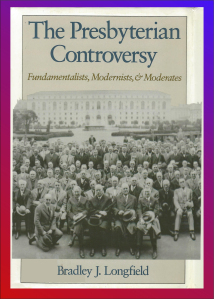Longfield Chronicles the Fundamentalist/Liberal Divide in the PCUSA, Part 1
 Bradley J. Longfield. 1991. The Presbyterian Controversy: Fundamentalists, Modernists, and Moderates. New York: Oxford University Press.
Bradley J. Longfield. 1991. The Presbyterian Controversy: Fundamentalists, Modernists, and Moderates. New York: Oxford University Press.
Review by Stephen W. Hiemstra
Have you ever experienced a déjà vu moment?
Reading good historical accounts can give one a sense of being a fly on the wall or even participating actively in the moment. It can also leave one with a sense of lost opportunity or loss glory. For Bradley Longfield’s The Presbyterian Controversy the past is more ominously a story from the past, a rehearsal, that informs the present.
Longfield (3) writes:
“The mainstream churches in America today face a serious crisis…Through the reasons for this hemorrhage in membership are many and complex, one contributor to the decline noted by analysts is the nebulous doctrinal identity of the churches…Without clear theological boundaries distinct from the ideals of the surrounding culture, the churches have been increasingly subject to cultural currents…The roots of this nebulous identity lie, at least in part, in the fundamentalist-modernist controversy of the 1920s. The churches in the 1920s, in response to the growth of liberal theology and the resultant reaction of fundamentalism, chose to allow for diverse doctrinal views in order to preserve institutional unity.”
So what was the fundamentalist-modernist controversy of the 1920s, who was involved, and why do we care?
Longfield (4) chronicles:
“From 1922 until 1936 the Presbyterian Church in the U.S.A. (PCUSA) was wracked by conflict. Sparked by a sermon of Dr. Harry Emerson Fosdick [“Shall the Fundamentalists Win”(9)], a liberal Baptist preaching in a Presbyterian pulpit, the Presbyterian controversy raged for fourteen years over such issues as ordination requirements, the mission of Princeton Seminary, and the orthodoxy of the Board of Foreign Missions.”
The controversy raged among leaders of the PCUSA denomination, including: J. Gresham Machen, William Jennings Bryan, Henry Sloane Coffin, Clarence E. Macartney, Charles R. Erdman, and Robert E. Speer. Longfield tells this tale by examining the biographies and thinking of these six men (5).
Why do we care? The PCUSA crisis today has its roots in the decisions made primarily in 1925, yet the same struggles persist as if the controversy occurred only last week. The question is: what fruits arose from the decisions made in this prior controversy?
At the time (1991) when Bradley J. Longfield wrote The Presbyterian Controversy he was a visiting professor of American Christianity at the Duke University Divinity School where he received his doctoral degree. He is currently Vice President and Dean of the Seminary and Professor of Church History at the University of Dubuque Theological Seminary. This book is written in 9 chapters, preceded by an introduction and followed by an epilogue, including:
The Conflict Erupts: Harry Emerson Fosdick and the Presbyterian Church,
Gresham Machen: Princeton Theology and Southern Culture,
Williams Jennings Bryan and the 1923 General Assembly,
Henry Sloane Coffin and the Auburn Affirmation,
Clarence E. Macartney and the 1924 General Assembly,
Charles R. Erdman and the 1925 General Assembly,
The Reorganization of Princeton and the Birth of Westminster,
Robert E. Speer and the Board of Foreign Missions, and
The Close of the Controversy: The Entanglement of Religion and Culture (ix).
The epilogue is followed by notes, a bibliography, and an index. The book cover depicts a group picture of the 1927 General Assembly of the PCUSA.
Longfield is an interesting read and a thorough biographer. For each personality chronicled, he discusses at length their personal background, education, the background of parents, idiosyncrasies, and influences. In many cases, serious influences are studied in like manner. In part 2 of this review, I will look at the particular controversies—ordination requirements, the mission of Princeton Seminary, and the orthodoxy of the Board of Foreign Missions—and in part 3 of this review, I will review the lessons learned.
Yogi Berra’s famously said: “It’s like deja-vu, all over again”. In French, déjà vu literally means—already seen—so his malapropos was hilariously redundant (http://bit.ly/1HK0wbJ).
Savage( 1996, 84-85) writes: “In the rehearsal story, the individual tells a story out of the past. Through hearing it, the listener can become aware that the event retold contains the same themes as the current problems facing the person.” Savage, John. 1996. Listening and Caring Skills: A Guide for Groups and Leaders. Nashville: Abingdon Press.
Jesus warned: “Beware of false prophets, who come to you in sheep’s clothing but inwardly are ravenous wolves. You will recognize them by their fruits. Are grapes gathered from thornbushes, or figs from thistles? So, every healthy tree bears good fruit, but the diseased tree bears bad fruit. A healthy tree cannot bear bad fruit, nor can a diseased tree bear good fruit. Every tree that does not bear good fruit is cut down and thrown into the fire. Thus you will recognize them by their fruits.” (Matt. 7:15-20 ESV)





